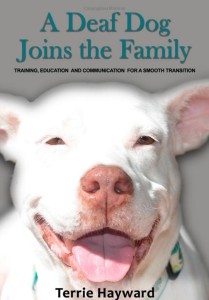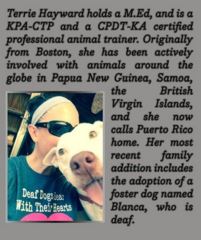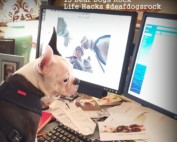Many of our deaf dog owners in our Deaf Dogs Rock community have to deal with Separation Anxiety (SA) with their deaf dogs because it seems to be more common in deaf dogs. Separation anxiety can rear it’s ugly head when you leave your home and come home to discover a destruction zone produced by your deaf dog or worse yet a six anxiety ridden pup. Separation anxiety occurs just by someone leaving their home (even for a short time), and after they leave, their dog goes into full distress. The dog’s anxiety is triggered when the dog becomes upset because they are separated from their human. Today I would like to welcome our guest blogger/trainer Terrie Hayward to teach us training solutions to help overcome your deaf dog’s Separation Anxiety. Welcome Terrie and thanks for taking the time to educate our readers on separation anxiety.
There Is A Solution For Separation Anxiety by Terrie Hayward – M.ED., KPA-CTP, CPDT-KA
Canine Separation Anxiety can be a frustrating, time consuming, and expensive (damages, veterinary bills, etc) disorder. It is painful for both dogs and their caregivers. Families may find out via complaints from neighbors of ongoing barking or with a return home to small or larger scale destruction or injury to the dog.
Often guardians end up feeling like prisoners in their own homes, unable to leave the dog alone for any length of time-sometimes even to just go to the curb to throw out the trash.
Unfortunately, Canine Separation Anxiety does not go away on it’s own. It’s a phobia; just like a fear of flying or of spiders.
What we see is like a panic attack. Dogs are not vocalizing or being destructive, etc. because they are bored or annoyed, but rather, because they are truly distressed at being left alone.
Just like a phobia of small spiders may seem unreasonable to some, in the eyes of the one who is fearful, the trepidation and panic is very real. Similarly, if we forced the person who was afraid of spiders to spend time surrounded by spiders they are sadly, not going to just begin to feel more comfortable with the spiders. This concept is called, “flooding.”
Flooding is when we force the dog to deal with the thing that they are most afraid of without the opportunity to escape. Again, as with the spider scenario the dog won’t, over time become more comfortable with the scary scenario, but may just “shut down,” or the fear may intensify.
Instead, what we do is to begin a specific protocol using detailed training called desensitization. Desensitization is defined as the diminished emotional responsiveness to a negative or aversive stimulus after repeated exposure to it over time. That means that in the case of Separation Anxiety, we help the dog in little, tiny, increments to very slowly feel okay about being alone. This means we work to change their reaction from “ah-my person is out of my sight for one minute and I really don’t feel good about this!” over time and with many repetitions to “ah-my person is out of my sight for one minute and they do this all the time, this game is actually kind of boring.”
The process of desensitization actually begins with with an assessment to determine the starting point. As above we mention a one minute absence. For some dogs this length of time may be too long to begin with. In fact, with deaf dogs, who rely on smell and sight, we will want to make sure that they actually see us move, and depending on the dog, this movement may only be across the room and back to start.
Treating Separation Anxiety isn’t complicated, it’s simple; it’s just not easy. We would begin by working to determine the dog’s threshold, or exact length of time before they become anxious and then creating succinct incremental steps would lead us to real, appreciable absences. As mentioned above, this length of time to start off may not even look like an “absence.”
Too, while we are going through the process, we actually make an agreement with the dog to suspend any and all actual absences outside of our specific protocol work on the issue. This is because we are building trust with the dog such that we are not forcing them into situations which they cannot currently handle and thus putting them into that panic state.
We start by establishing a “contract” with our deaf dog to suspend absences outside of our protocols and to work within the threshold where he is comfortable. Very slowly and with many (many!) repetitions we are working to help him to feel more and more secure with being alone.
The solution for Separation Anxiety is often as arduous as it is painfully slow. The tedious repetitions are what enable us to lengthen the absence protocol steps, however regressions are common and progress sometimes plateaus before again moving forward.
At the beginning this is an excruciatingly slow process, but eventually seconds turn into minutes, and minutes mount up into longer and longer absences.
The process will require your commitment and continued consistency.
With slow and steady commitment over time you can make appreciable progress towards a resolution. Separation anxiety does have a solution which can make your life and your dog’s much more relaxing and comfortable.
For additional assistance, Terrie Hayward is the owner of PAW-Positive Animal Wellness, LLC. She is the author of the pocket guide to working with deaf dogs titled, A Deaf Dog Joins the Family, Training, Education, and Communication for a Smooth Transition.
Terrie holds a Master’s Degree in Education, is a Karen Pryor Academy Certified
Training Partner, and is a Certified by the Council for Professional Dog Trainers.
Additionally, she is an Associate Certified member of the International
Association of Animal Behavior Consultants, and is a Certified Separation
Anxiety Trainer.
Terrie specializes in treating Canine Separation Anxiety and working with deaf
dogs. Visit her website at http://positiveanimalwellness.com/contact/ or via her
FaceBook page at https://www.facebook.com/PositiveAnimalWellness.













